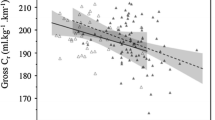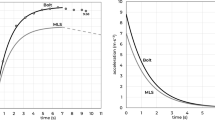Summary
The energy output is investigated during running at constant speed with varying length of stride and stride frequency.
The results show that the most economical stride length always lies in the region of the freely chosen one when the subject is well-trained. An increase of stride length above the freely chosen one gives a larger increase of O2-consumption than a corresponding shortening of the stride. There is for every runner and every speed an optimum of stride length and frequency.
Similar content being viewed by others
References
Fenn, W. O.: Amer. J. Physiol.93, 433 (1930).
Schuppe, H.: Physik der Leibesübungen.
Author information
Authors and Affiliations
Additional information
With 2 graphs in the text.
Rights and permissions
About this article
Cite this article
Högberg, P. How do stride length and stride frequency influence the energy-output during running?. Arbeitsphysiologie 14, 437–441 (1952). https://doi.org/10.1007/BF00934423
Received:
Issue Date:
DOI: https://doi.org/10.1007/BF00934423




